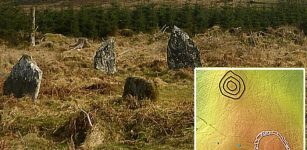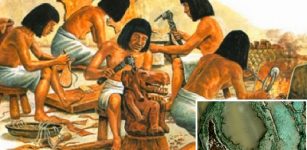New West Papua Findings Provide Insights Into Early Human Migration To The Pacific
AncientPages.com - In the deep human past, highly skilled seafarers made daring crossings from Asia to the Pacific Islands. It was a migration of global importance that shaped the distribution of our species – Homo sapiens – across the planet.
These mariners became the ancestors of people who live in the region today, from West Papua to Aotearoa New Zealand.
Archaeologists Daud Tanudirjo and Moses Dailom excavating at Mololo Cave. Tristan Russell, CC BY-SA
For archaeologists, however, the precise timing, location and nature of these maritime dispersals have been unclear.
For the first time, our new research provides direct evidence that seafarers travelled along the equator to reach islands off the coast of West Papua more than 50 millennia ago.
Digging at the gateway to the Pacific
Our archaeological fieldwork on Waigeo Island in the Raja Ampat archipelago of West Papua represents the first major international collaboration of its kind, involving academics from New Zealand, West Papua, Indonesia and beyond.
We focused our excavations at Mololo Cave, a colossal limestone chamber surrounded by tropical rainforest. It stretches a hundred metres deep and is home to bat colonies, monitor lizards and the occasional snake.
In the local Ambel language, Mololo means the place where the currents come together, fittingly named for the choppy waters and large whirlpools in the nearby straits.
Excavation uncovered several layers of human occupation associated with stone artefacts, animal bones, shells and charcoal – all physical remains discarded by ancient humans living at the cave.
These archaeological findings were rare in the deepest layers, but radiocarbon dating at the University of Oxford and the University of Waikato demonstrated humans were living at Mololo by at least 55,000 years before the present day.
Foraging in the rainforest
A key finding of the excavation was a tree resin artefact that was made at this time. This is the earliest example of resin being used by people outside of Africa. It points to the complex skills humans developed to live in rainforests.
Scanning-electron microscope analysis indicated the artefact was produced in multiple stages. First the bark of a resin-producing tree was cut and the resin was allowed to drip down the trunk and harden. Then the hardened resin was snapped into shape.
The tree resin artefact found at Mololo Cave dates back to 55,000 to 50,000 years ago. The chart shows how it may have been made and used. Dylan Gaffney, CC BY-SA
The function of the artefact is unknown, but it may have been used as a fuel source for fires inside the cave. Similar resin was collected during the 20th century around West Papua and used for fires before gas and electric lighting was introduced.
Our study of animal bones from Mololo indicates people hunted ground-dwelling birds, marsupials and possibly megabats. Despite Waigeo Island being home to small animals that are difficult to capture, people were adapting to using rainforest resources alongside the coastal foods islands readily offer. This is an important example of human adaptation and flexibility in challenging conditions.
Seafaring pathways to the Pacific
The Mololo excavation helps us to clarify the precise time humans moved into the Pacific. This timing is hotly debated because it has major implications for how rapidly our species dispersed out of Africa to Asia and Oceania.
A modern example of tree resin from the Raja Ampat Islands being used for starting a fire. Dylan Gaffney, CC BY-SA
It also has implications for whether people drove Oceanic megafauna like giant kangaroos (Protemnodon) and giant wombats (Diprotodontids) to extinction, and how they interacted with other species of hominins like the “hobbit” (Homo floresiensis) that lived on the islands of Indonesia until about 50,000 years ago.
Archaeologists have proposed two hypothetical seafaring corridors leading into the Pacific: a southern route into Australia and a northern route into West Papua.
In what is today northern Australia, excavations indicate humans may have settled the ancient continent of Sahul, which connected West Papua to Australia, by 65,000 years ago.
However, findings from Timor suggest people were moving along the southern route only 44,000 years ago. Our work supports the idea that the earliest seafarers crossed instead along the northern route into West Papua, later moving down into Australia.
Two possible seafaring pathways from Asia to the Pacific region: a northern route along the equator to Raja Ampat and a southern route via Timor to Australia. Dylan Gaffney, CC BY-SA
West Papua: an archaeological enigma
Despite our research, we still know very little about the deep human past in West Papua. Research has been limited primarily because of the political and social crisis in the region.
Importantly, our research shows early West Papuans were sophisticated, highly mobile and able to devise creative solutions to living on small tropical islands. Ongoing excavations by our project aim to provide further information about how people adapted to climatic and environmental changes in the region.
Hand stencils of unknown age from the Raja Ampat Islands. Tristan Russell, CC BY-SA
We know from other archaeological sites in the independent country of Papua New Guinea that once humans arrived in the Pacific region, they kept venturing as far as the New Guinea Highlands, the Bismarck Archipelago and the Solomon Islands by 30,000 years ago.
It was not until about 3,000 years ago that seafarers pushed out beyond the Solomon Islands to settle the smaller islands of Vanuatu, Fiji, Samoa and Tonga. Their descendants later voyaged as far as Hawaii, Rapa Nui and Aotearoa.
Charting the archaeology of West Papua is vital because it helps us understand where the ancestors of the wider Pacific came from and how they adapted to living in this new and unfamiliar sea of islands.
The authors acknowledge the contribution of Abdul Razak Macap, a social anthropologist at the Regional Cultural Heritage Center in Manokwari.
Provided by The Conversation
This article is republished from The Conversation under a Creative Commons license. Read the original article.
More From Ancient Pages
-
 Chinese Invention: World’s First Known Movable Type Printing
Ancient History Facts | Dec 30, 2014
Chinese Invention: World’s First Known Movable Type Printing
Ancient History Facts | Dec 30, 2014 -
 Unusual Skeletons And Mysterious Ancient Artifacts Covered With Unknown Characters Discovered In West Virginia By Archaeologists
Featured Stories | Feb 22, 2024
Unusual Skeletons And Mysterious Ancient Artifacts Covered With Unknown Characters Discovered In West Virginia By Archaeologists
Featured Stories | Feb 22, 2024 -
 On This Day In History: Mathematician And Astronomer Simon Marius Independently Rediscovered Andromeda Galaxy – On Dec 15, 1612
News | Dec 15, 2016
On This Day In History: Mathematician And Astronomer Simon Marius Independently Rediscovered Andromeda Galaxy – On Dec 15, 1612
News | Dec 15, 2016 -
 First Genetic Map Of People Of Ireland Is Presented By Irish, British And American Researchers
Archaeology | Dec 15, 2017
First Genetic Map Of People Of Ireland Is Presented By Irish, British And American Researchers
Archaeology | Dec 15, 2017 -
 Creepy And Unusual Ancient Skull Found In Small Crypt Investigated By Scientists But Can They Solve The Mystery?
Ancient Mysteries | Feb 2, 2025
Creepy And Unusual Ancient Skull Found In Small Crypt Investigated By Scientists But Can They Solve The Mystery?
Ancient Mysteries | Feb 2, 2025 -
 Excavations of the Aşıklı Mound, Cappadocia , Turkey
Civilizations | Aug 22, 2015
Excavations of the Aşıklı Mound, Cappadocia , Turkey
Civilizations | Aug 22, 2015 -
 2,000-Year-Old Skull Reveals Ancient Romans May Have Been The First To Breed Flat-Faced Dogs
Archaeology | Jun 15, 2023
2,000-Year-Old Skull Reveals Ancient Romans May Have Been The First To Breed Flat-Faced Dogs
Archaeology | Jun 15, 2023 -
 Unique 17th Century Sunken Swedish ‘Bodekull’ Ship – Identified
Archaeology | Jun 24, 2017
Unique 17th Century Sunken Swedish ‘Bodekull’ Ship – Identified
Archaeology | Jun 24, 2017 -
 Death Of Norse God Balder And Loki’s Mischief That Led To Destruction In Ragnarok
Featured Stories | Nov 15, 2016
Death Of Norse God Balder And Loki’s Mischief That Led To Destruction In Ragnarok
Featured Stories | Nov 15, 2016 -
 Baltinglass Hills: Prehistoric Irish Monuments May Have Served As Pathways For The Deceased – New Evidence
News | Apr 30, 2024
Baltinglass Hills: Prehistoric Irish Monuments May Have Served As Pathways For The Deceased – New Evidence
News | Apr 30, 2024 -
 Exceptional 1,700-Year-Old Roman Mosaics Have Returned Home To Israel
Archaeology | Jun 27, 2022
Exceptional 1,700-Year-Old Roman Mosaics Have Returned Home To Israel
Archaeology | Jun 27, 2022 -
 What Ancient Civilization Discovered Metallurgy?
Ancient Technology | Sep 19, 2017
What Ancient Civilization Discovered Metallurgy?
Ancient Technology | Sep 19, 2017 -
 Skull Of Mysterious, Extinct Cousin Of Neanderthals Recreated From A Fossilized Finger
Archaeology | Sep 19, 2019
Skull Of Mysterious, Extinct Cousin Of Neanderthals Recreated From A Fossilized Finger
Archaeology | Sep 19, 2019 -
 Neanderthals And Homo Sapiens Invented Different Fire Techniques – Evolution Of Human Cognition
Archaeology | Jun 1, 2023
Neanderthals And Homo Sapiens Invented Different Fire Techniques – Evolution Of Human Cognition
Archaeology | Jun 1, 2023 -
 Rare Roman Mosaic Of Amazon Warriors Unearthed In Syria Hailed As Major Archaeological Discovery
Archaeology | Oct 12, 2022
Rare Roman Mosaic Of Amazon Warriors Unearthed In Syria Hailed As Major Archaeological Discovery
Archaeology | Oct 12, 2022 -
 Myth Of The Pale Sun Followed By A Catastrophe Confirmed By Archaeologists
Featured Stories | Sep 22, 2024
Myth Of The Pale Sun Followed By A Catastrophe Confirmed By Archaeologists
Featured Stories | Sep 22, 2024 -
 Odd Ancient Dwellings Of The Snake People – Clues From Biblical Lands – Part 2
Ancient Mysteries | Sep 10, 2020
Odd Ancient Dwellings Of The Snake People – Clues From Biblical Lands – Part 2
Ancient Mysteries | Sep 10, 2020 -
 Does A Baffling Artifact Offer Evidence Of Ancient Extraterrestrial Visitation In New Zealand? – Experts Investigate – Part 2
Ancient Mysteries | Jul 23, 2020
Does A Baffling Artifact Offer Evidence Of Ancient Extraterrestrial Visitation In New Zealand? – Experts Investigate – Part 2
Ancient Mysteries | Jul 23, 2020 -
 Evidence Humans Walked The Great Plains 18,000 Years Ago May Have Been Found – Archaeologists Say
Archaeology | Mar 14, 2022
Evidence Humans Walked The Great Plains 18,000 Years Ago May Have Been Found – Archaeologists Say
Archaeology | Mar 14, 2022 -
 Vijayanagara – ‘City Of Devas – Shining Ones’ – Place Where Mythology And History Coexist
Civilizations | Jun 21, 2015
Vijayanagara – ‘City Of Devas – Shining Ones’ – Place Where Mythology And History Coexist
Civilizations | Jun 21, 2015





